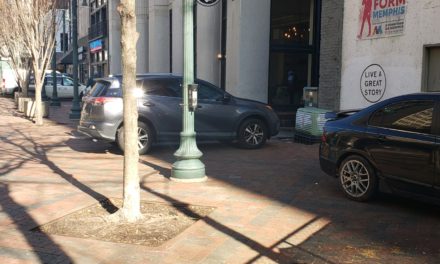If, as most of us agree, the purpose of life is to leave things better than we found them, Paul Morris should be justifiably proud of his five years at the helm of the Downtown Memphis Commission.
When he became president of the development agency, arguably the biggest problem facing downtown was that it was failing at the basics. Main Street was in sad shape, hundreds of employees were being moved away without a fight, blight was accepted as a fact of daily life, and the work of the agency regularly seemed more political than strategic.
Today, as he prepares to step down as president, while much remains to be done for downtown to ever be described as vibrant, including breaking the code on retail development, there is progress that inspires new energy and aspirations that seem more than just wishful thinking. And it’s not been possible to say that for more than a decade.
As Mr. Morris showed in his comments to our recent post on the need for better connectivity and programming in downtown, particularly along the riverfront, he is sensitive about the record of the past five years and that actually is evidence of the most significant change he has brought to the work of the Downtown Memphis Commission.
Changing The Culture
While he can give a running inventory of downtown projects, in truth, the most important contributions he’s made are intangible, not tangible. His unflinching advocacy of downtown drove him to fight for it on all fronts, and his emails and letters to political leaders and business leaders were assertive and according to some recipients, caustic. As for us, that’s not a complaint but a compliment to his brand of leadership.
An example was the subject of a 2011 blog post: “Real” Downtowns Have Champions.” Faced with the City of Memphis moving too slow on dealing with a collapsing building downtown, he sent up a flare that demanded action, and he was able to close the Chisca Hotel and One Commerce Square deals by successfully lobbying for direct funding from City of Memphis.
Prior to his arrival, the Center City Commission, forerunner to the Downtown Memphis Commission, devolved from its original structure and purpose into a heavily politicized organization whose board was larded with politicians and the agency took on a “go along to get along” attitude that seemed to keep it on its heels and to even round off its responses to the relocation of some major downtown employers eastward.
In the past five years, however, Mr. Morris and his staff fought to keep jobs downtown, calling for political help, pleading with business leaders for their support, and rallying constituents. That’s not to say it hasn’t been an uphill battle. After all, the Memphis MSA ranks #1 as the most decentralized MSA (for smaller employment regions) with 12.4% of the MSA’s jobs within three miles of downtown, compared to the national average of 23%. Meanwhile, among the 100 largest U.S. cities, downtown Memphis ranked #38 in population growth from 2000 to 2010: +22%.
Times Have Changed
Dozens of the major cities in the U.S. are cut off on one side by a river and as a result, their downtowns are not in a classic central location. Many of them succeed where Memphis falters because of the concerted effort of local government to wholeheartedly make their downtowns’ quality of life the best in their community, to provide a high-quality public sphere, and to act on a comprehensive plan for making and keeping them vibrant.
That’s not to say that downtown Memphis does not have strengths to build on: 16.7% of the Memphis workforce is there on only two percent of the city’s land area and it is the indisputable center of the region’s tourism industry with more than eight million visitors a year to Beale Street and Bass Pro Shops alone. As we wrote last week, a major priority for Morris’ successor should in finding a way to create a coalition dedicated to coaxing these millions of visitors onto Main Street to support existing businesses and to spark new ones.
But we digress. After 44 years of working downtown, we can’t imagine going anywhere else every day. It’s far different now than we came. Back then, Main Street was bustling with shoppers, Court Square was jammed with people each day at lunch, and there was no dispute that downtown was the center of the universe for Memphis.
But that was then and that Memphis is gone. From a downtown brimming with businesses and little residential, it has become just the opposite, and today, it must find its way with these new realities.
The Proudest Moments
Back to our earlier point, Memphis and Shelby County (when the Center City Commission was founded, county government appropriated CIP money for downtown but it hasn’t for many years) need to agree to an aggressive investment plan that upgrades the infrastructure (sidewalks, alleys, etc.), that improves the streetscape, that upgrades experiential options, and that funds programming that delivers on the promise that downtown events, festivals, concerts, and activities are ubiquitous so that that also is known as the single, best destination for dependably finding fun in a distinctively authentic environment.
Back to Mr. Morris, we recently emailed him about his proudest moments at the Downtown Memphis Commission. He responded that the things that immediately came to mind were “Chisca, Main-to-Main, saving One Commerce Square from going dark with major reinvestment, effective interim management of Beale St., aggressive blight reduction, James Lee House, Pressbox Lofts f/k/a Toof, South Main branding and revitalization leading to $500M in development projects, small fun things like The Barking Lot and Bocce Ball court, many public art projects, assembling and motivating an excellent staff.” And that action-oriented list didn’t even include the Central Station development and Tennessee Brewery projects, the smart demonstration blocks strategy, and more.
In particular, there are two major accomplishments that have impressed us most: the blight fight and Main Street repairs. Mr. Morris’ “take no prisoners” stand on downtown blight. No one has ever been as aggressive or persistent in fighting blight in downtown, and that approach should serve his successor well. As we’ve written before, while the Harahan Bridge’s bike/ped plan is exciting, what excited us were the substantial repairs to Main Street. After more than a decade of amateurish plywood repairs of broken drainage grates and hundreds of cracked pavers, Main Street is a place where we can finally proudly walk again with visitors to Memphis.
Positioned For The Future
We’ve blogged in the past about the difference between the downtown PILOT program and the sister program run by EDGE, but we’re encouraged that in his last weeks as president of the Downtown Memphis Commission, he and his boards have begun a long overdue conversation about limiting or better targeting its tax freezes. Most of all, with apartment occupancies approaching 95%, it’s getting hard to argue that PILOTs for these projects should not be reevaluated and the DMC is questioning the wisdom of waiving taxes for limited service hotels.
The reality for Downtown Memphis Commission is that projects, challenges, and policies are like icebergs. There is always so much more below the surface: Problem properties, blight, multiple or absentee ownership, real estate speculation, infrastructure issues discouraging investment, one-way streets inhibiting maximum exposure to potential customers driving downtown, disconnected pods of activity, and questions that remain to be answered like whether traffic on Main Street could be a benefit in spurring retail.
Many of these questi0ns and factors were addressed in the report, 12 Modest Suggestions for Making Memphis Great, written by Jeff Speck, former director of design for the National Endowment for the Arts, planner and architect, and author of several books, including Walkable City: How Downtown Can Save America, One Step at a Time and it’s a good place on which to build an agenda for action. To that point, a post last year on Planetizen, 12 Strategies To Transform Downtown could also be useful in setting ambitions.
As he leaves the Downtown Memphis Commission to manage Jack Morris Auto Glass, the family business founded by his father, an outstanding civic and political leader, Mr. Morris leaves downtown in substantially better shape than when he found it. With so much improvement to downtown’s basics, his successor and the various boards of the Downtown Memphis Commission can double down on some of downtown’s most challenging issues and strategic decisions that are coming more clearly into focus and develop a long-term vision and the strategies to achieve it. Most of all, the agency now has the right attitude, organizational culture, and the public persona to do it.
***
Join us at the Smart City Memphis Facebook page for daily articles, reports, and commentaries that are relevant to Memphis.





I honestly don’t think Mr Morris has a lot to be proud of after 5 years because Downtown Memphis is still in sad shape. Perhaps he’s helped make some small improvements, but downtown still has too much blight and is far from being vibrant. The Downtown Memphis Comission, like everything else here, is still very political and does not accomplish much. That’s just the way things happen in the Bluff City.
Paul has substantially raised the civic leadership bar. His intelligence, integrity, persistence, vision, and commitment will be very difficult to match. He understands and deftly navigates the turbulent waters of both the political and private interests that so often affect the DMC’s ability to accomplish what it has.
Paul’s business background provides him with an entrepreneurial approach to downtown development that biased the DMC to bold action. His experience as an attorney gives him the ability to incisively analyze the options available. His personal integrity compels him to choose the morally correct, even when often politically unpopular path.
He would be the last to describe himself as a knowledgable designer, but he does thoroughly understand the importance to downtown’s success of a vibrant and beautiful public realm and has aggressively promoted better design in downtown, including multiple public art projects and stronger sign and design guidelines.
Paul Morris set a new standard for the DMC. By his example, he inspired those around him including both staff and board members to reach higher and demand excellence. His successor will find him a hard act to follow.
A good man who accomplished many good things. He will be missed.
HE WILL BE GREATLY MISSED!! PEOPLE HAVE NO IDEA HOW GREAT HE IS AND HOW HARD HE HAS WORKED TO BRING SO MUCH TO DOWNTOWN.
Paul Morris has run DMC for the past several years and Downtown is a better place because of him. In his years as leader we have seen the Tennessee Brewery saved, One Commerce Square saved, the redevelopment of the Chisca, growth of Main Street as a restaurant and entertainment district, and much, much more.